Menu
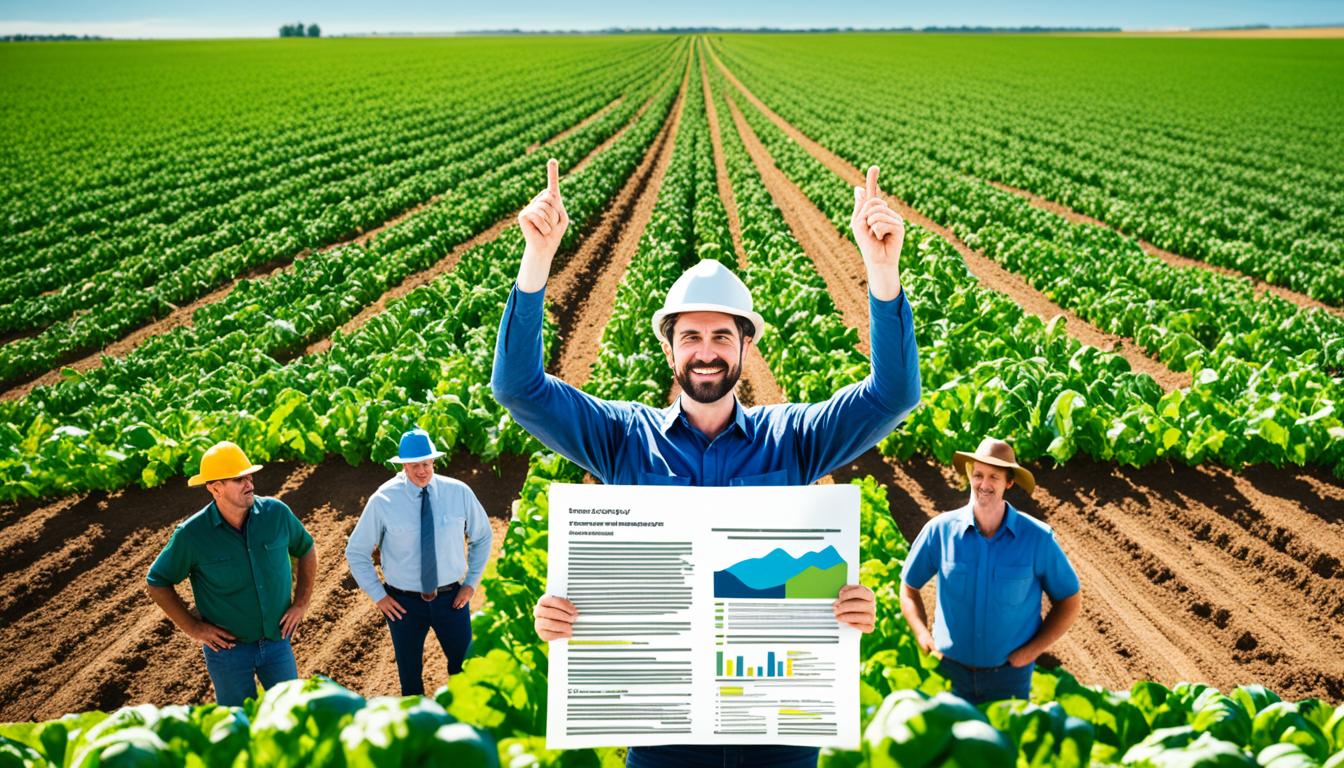
Every five years, the United States creates a new Farm Bill that affects farming for years to come. The latest one, the Agricultural Improvement Act of 2018, is in effect until 2023. It helps farmers by providing rules for their work and helps the farming community grow.
Due to the COVID-19 pandemic, the United States Department of Agriculture gave $16 billion to help farms. Each farm could get up to $250,000. This helped them tackle the financial impacts of the pandemic. These efforts are part of modern policies aimed at facing new challenges in farming.
Knowing about changes in farming laws and the latest policies is very important. These updates can help a farm grow or may change how a farm operates. It’s key for farmers to keep up with these changes to be successful in their business.
The American agricultural policy has a deep and complex history. It has changed a lot since the Great Depression. It started by helping farmers with their financial struggles. Over the years, it has adapted to account for different economic and environmental needs.
American farmers were in a bad situation during the Great Depression. Prices for their products were really low. Then, the 1929 stock market crash added to their problems. The government had to step in to help.
The Agricultural Adjustment Act (AAA) of 1933 was a key intervention. It was part of President Roosevelt’s New Deal. It aimed to support farmers by increasing prices for their products. It did this by limiting production and offering direct subsidies. This act laid the foundation for more farm support laws to come.
After the hard times of the Great Depression, farming laws adapted to new realities. The Federal Land Bank System, starting in 1916, offered farmers important credit. Other laws, like the Smith-Lever Act of 1914, helped farmers work better together. This support boosted their crops.
After World War I, the government started to set fair prices for certain foods. This helped keep the market steady. But these supports faced challenges as other countries started to produce more food. This led to price drops in the 1920s.
In the last few decades, policy has evolved even more. Since 1985, the government has spent a lot more on agricultural programs. This shows a deeper commitment. It’s also seen through regular Farm Bills like the one in 2018. These bills keep getting updated to meet today’s farming needs.
The most recent policies have been quick to react to new challenges. The COVID-19 pandemic is a great example. Targeted help has been essential to keep the agricultural sector strong.
| Period | Focus | Key Legislation |
|---|---|---|
| 1785-1890 | Land Distribution and Settlement | Homestead Act of 1862 |
| 1830-1914 | Improving Productivity | Smith-Lever Act of 1914 |
| 1870-1933 | Market Regulation and Infrastructure | Agricultural Adjustment Act of 1933 |
| 1924 onwards | Income Support and Intervention | Farm Bills |
Looking back, it’s clear that agricultural policy has made a big difference to American farming. It has taught us how to overcome challenges and change with the times.
The Farm Bill is crucial to the United States’ farming policies. It’s updated every five years to meet the evolving needs of agriculture. This law touches on farming, food, community welfare, and financial support.
The 2018 version, known as the Agricultural Improvement Act of 2018, covered key areas. These included policies on crops, protection for farmers, keeping land healthy, and growing trade. This act guides the sector from 2018 to 2023, building on the 2014 rules. A major change was allowing industrial hemp to be grown.
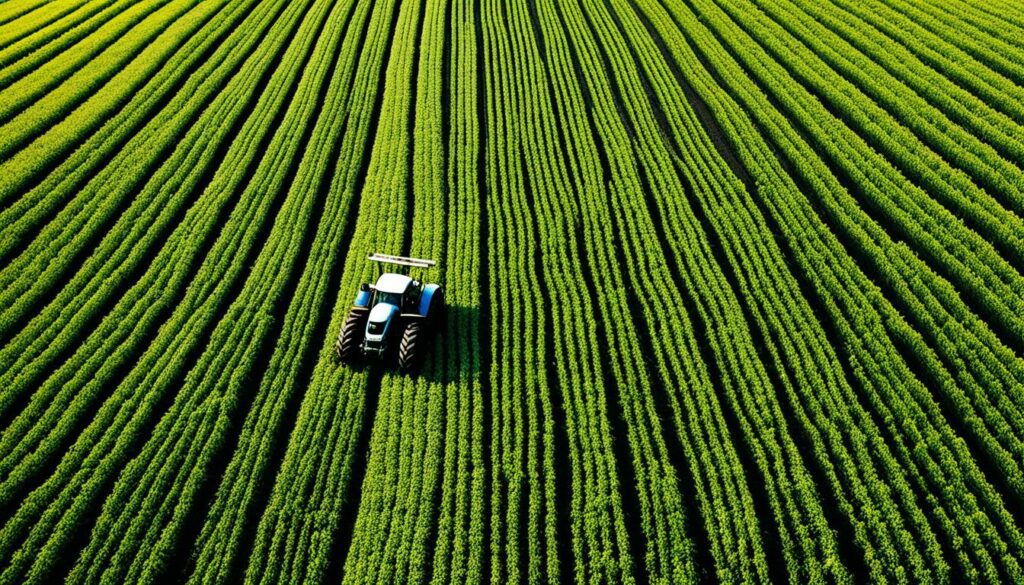
Over five years, the 2018 Farm Bill is set to cost $428 billion. It aims to help the agricultural sector succeed while facing new challenges. It includes twelve main points, such as rules for farming goods, land protection, supporting dairy farmers, and promoting organic food.
How the Farm Bill is made is interesting. It’s a long process involving many steps like debates in Congress and with the President. This way, it makes sure to meet the needs of all in the farming world.
The Farm Bill also affects the U.S. on the world stage. It involves reporting aid to agriculture to the World Trade Organisation and working with the OECD. This shows the U.S.’s role in global agriculture decisions and policies.
Let’s look at how the 2018 Farm Bill’s money was divided:
| Title | Focus Area | Budget (Billions) |
|---|---|---|
| I | Commodity Programs | 61 |
| II | Conservation | 60 |
| III | Trade | 3.6 |
| IV | Nutrition | 326 |
| V | Credit | 0.5 |
| VI | Rural Development | 2 |
| VII | Research | 0.8 |
| VIII | Forestry | 0.8 |
| IX | Energy | 0.3 |
| X | Horticulture | 0.9 |
| XI | Crop Insurance | 0 |
| XII | Miscellaneous | 2.1 |
Agricultural policy quickly adjusts to crises, like the COVID-19 pandemic. It needed swift actions to protect itself from market issues and challenges.
During the pandemic, short-term policies were focused on helping farmers. In 2020, the USDA provided $16 billion to soften the COVID-19 farming impact. This showed how important fast government help is in hard times.
This money went to help farms deal with supply chain problems and lower demand. Each business could get up to $250,000. Although it was only for a short time, it really helped the farming sector tackle immediate problems.
Temporary agricultural aid clearly showed the importance of quick help. It aimed to support areas with big troubles. It ensured the farm areas kept going and got the help they needed. This included not just money but also more time to pay loans and grants.
The USDA also worked to keep food moving during the pandemic. It tackled worsening food security problems.
| Year | Policy Implemented | Relief Amount | Conditions |
|---|---|---|---|
| 2020 | COVID-19 Relief Programme | $16 Billion | Maximum $250,000 per business |
| 2020 | Loan Extensions | Various | Extended deadlines |
These steps were essential to protect the farming sector. They ensured it could bounce back from instant problems and prepare for future shocks. The U.S.’s quick actions in the pandemic show a model for other countries to follow in times of crisis.
Agricultural policy keeps changing to bring new chances mixed with strict rules. These changes make sure farmers use sustainable methods and stay financially sound too. The USDA’s Conservation Loan Programme is a great example of this mix.
The USDA’s Conservation Loan Programme offers money to farmers who want to be more eco-friendly. It aims to boost sustainable farming. Farmers who join can get extra cash. This helps them improve their farms in eco-friendly ways.
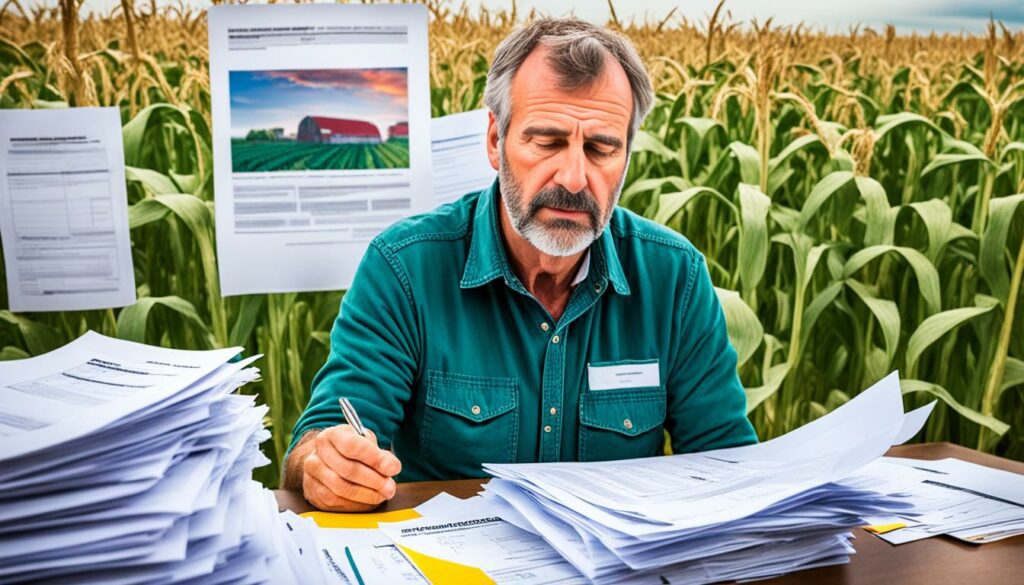
The Programme gives farmers financial help upfront. But, it has rules to follow. These rules are about using the money for eco-friendly farming. This can change how a farm works. For example, it might influence how much they produce or earn.
Here’s what’s key in understanding the Programme:
| Aspect | Benefit | Limitation |
|---|---|---|
| Financial Assistance | Quick money for green farming. | Need to meet compliance rules adds work and costs. |
| Eco-Friendly Practices | Helps in sustainable farming that protects the planet. | May mean changing how you work or what you produce. |
| Compliance | Promotes following strict plans for conservation. | It takes time and might cost more to follow the rules. |
Farmers must see both the good and the challenging parts of this Programme. It needs them to carefully balance the benefits with the rules. This makes sure their farming is both profitable and eco-friendly. The Programme shows a trend towards policies that mix money and environment needs. It also shows how these policies affect farmers.
Agricultural policies greatly affect agribusiness, from promoting crop growth to protecting against losses and making loans available. For example, during COVID-19, the USDA provided $16 billion to help struggling agribusinesses. Yet, each agribusiness could only receive up to $250,000. This shows how important it is to balance support in policy.
The recently passed Agricultural Improvement Act of 2018 will be in effect until 2023. It brings in new programs and updates existing ones every five years. This helps keep agribusinesses aligned with the latest needs and market trends. The USDA’s Conservation Loan Program, part of FSA, supports green projects with loans.
Policy shifts sometimes require farmers to change what they grow or how they operate. Changes could include producing less of certain crops or helping with income if crops fail. They might also make FSA loans easier to get. These changes often push farmers to grow different crops or use new methods to meet market and policy demands.
If policies stop farmers from growing regular crops, they might want to try growing herbs or flowers. In such cases, working with a banker who knows about agribusiness banking can really help. They keep farmers informed about policy changes, making sure they can adjust their farming and business plans quickly.
Here, we can see the impact of the USDA on agribusiness through key financial support:
| Program | Purpose | Funding Limit |
|---|---|---|
| Pandemic Relief Fund | Assisting agribusinesses during COVID-19 | $16 billion (up to $250,000 per business) |
| Conservation Loan Program | Promoting eco-friendly practices | Varies by loan |
| Agricultural Improvement Act of 2018 | Providing ongoing policy adjustments | Effective until 2023 |
Knowing how agricultural policy and finance work together is key for farmers. They can mix things like agricultural policy finance with tools such as farming loans and subsidies. This helps them not just keep their farms running but make them grow.

Farming loans and subsidies play a big role in supporting farms. In 54 studies, some found more help from these than others. There are different types of aid, like cash help, loan guarantees, and tax breaks.
The USDA’s Conservation Loan Program, for example, helps farmers go green. These loans help with eco projects but need a green plan from the Natural Resources Conservation Service. Knowing how to use such programs is vital for farm success.
Staying in tune with what consumers need keeps farms going strong. A 2022 report highlighted US policies that supported eco-friendly products. These changes look at big issues like climate change and COVID-19 as well as shopper tastes.
In 2022, new food programs and health strategies were launched to link farming with what people eat. Using these, farmers can grow different crops and find new buyers.
| Study Focus | Number of Studies |
|---|---|
| Impact of Policy on Production | 54 |
| Land Allocation (Crop Diversification, Acreage Expansion) | 25 |
| Efficiency | 23 |
| Employment Rates (On- and Off-Farm) | 18 |
| Farm Income | 17 |
Mixing agricultural policy finance with farming loans, subsidies, and consumer incentives helps farmers build strong businesses. Understanding policy and managing money right is key in today’s farming world.
Every time agricultural policy changes, it brings many challenges. Those involved need to quickly adjust. This is especially true when looking at how policies affect their short and long-term plans. Out of more than 103 articles, we found that changes in farming rules affect things like what is produced, where, and how well.
About 54 studies looked into how government changes affect what farms produce. They found that tweaks to the rules really do change how much food and other products farms make. Things like getting money or tax breaks can help a lot. But, they must fit well with what farms are already doing.
Despite only a small amount of land being good for farming and needing a lot of water, the issues are not just about money. Farming also plays a big part in climate change. It causes a lot of the world’s greenhouse gases. Yet, in the European Union, most of the plants we grow need animals like bees to pollinate them. This shows why we need rules that protect both the environment and the animals in it.
By 2050, we’ll need much more food because the world’s population is growing fast. But now, in poorer countries, most food comes from small farms. These farms don’t produce as much as big farms in richer places. We need smart rules that help small farms grow without harming the planet.
It’s also interesting that 180,000 people leave the countryside every day. This creates big problems. We need rules that keep people working in farming and help new jobs appear. Balancing this with the need for new kinds of farming rules is important. It shapes the future of rural areas and farming in general.
To work in farming, you have to understand these challenges well. Dealing with changes in agricultural policy means always learning and changing how you do things. This makes it possible to meet both short and long-term goals.
As farming rules change, we need to change with them. This way, we can improve how we farm, keep up with growing demands, and protect the environment.
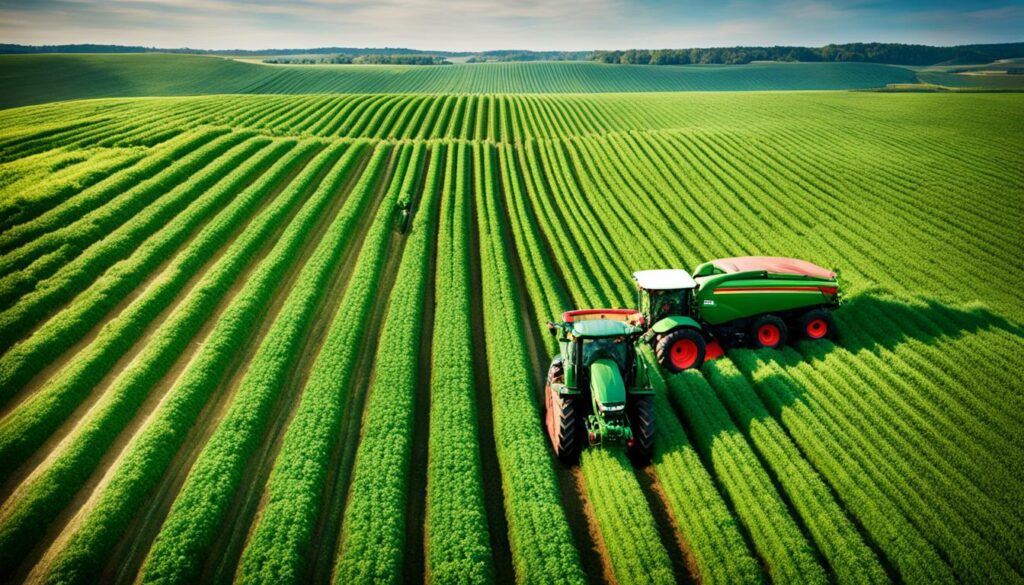
In the changing world of agriculture, knowing about agricultural finance is very important. Agricultural bankers help agribusinesses deal with new rules and policies. Thanks to their expert knowledge, they can give both banking help and smart advice on handling new regulations.
This means agribusinesses can follow the rules and find chances to grow. Bankers guide them in the finance side of things to make use of loans and subsidies well. They focus on recent policy changes, like simpler rules for some crops and new farming methods, to help their clients.
Bankers are not just for handling money. With the U.S. facing agricultural trade issues recently, bankers need to know a lot about farm finance. They guide farmers on how to use loans and subsidies wisely, especially now with new farming methods allowed due to policy changes.
This includes understanding about lending, investing, and managing farming risks. They are key in making sure farmers can make the most of these financial tools. Their advice is vital in these changing times, helping farmers grow despite financial challenges.
Agricultural policies change all the time, affected by big global events. For example, the Risk Management Agency sought to boost local farming after Russian events in Ukraine. Bankers must always stay informed of these updates to give accurate advice.
They keep track of policy changes and legal moves, which helps them provide up-to-date guidance. One example was when German farm fuel subsidies were cut, causing protests. Such cases show the importance of bankers keeping in touch with the latest news for their clients.
Bankers play a central role in helping agribusinesses work through complex policies. They use their knowledge of agricultural finance to support agricultural growth. Their detailed understanding of navigating policy changes means their clients can be both compliant and ready for new market opportunities.
Agriculture is always changing. New policies mean both chances and challenges for farmers. For example, adding different plants can boost the number of various genes in one area. This can lead to more opportunities in farming. Yet, following new rules may cost more than farmers expect.
For farming businesses, smart planning is key. Including more types of animals can cut down on harmful bugs and sickness. It also helps the soil be healthier. But, starting this might be expensive and not all farmers are sure it will work.
Some rules promote mixing different plants in fields or in lines. This makes farms more interesting and good for the environment. It also means farmers might sell more. Plus, it helps keep the land in good shape against the weather.
Growing trees with crops is another good idea. It helps deal with extreme weather and keeps the soil strong. But, changing to these methods takes time and can be risky at first.
| Positive Impacts | Potential Risks |
|---|---|
| Enhanced genetic diversity | Investment in compliance |
| Increased marketable yields | Initial implementation costs |
| Climate resilience | Uncertainty with new strategies |
| Improved soil health | Transitioning from traditional methods |
Farm help from different governments varies a lot. It can go from 1% to more than 50% of what farmers make. Places like Japan, Korea, and Switzerland offer more direct help to farmers. But, Australia focuses on backing the whole farming community.
Looking closely at the chances and challenges of new farm rules is very important. With the right plan, farmers can handle the changes well. They can even make the most of the good things the new rules bring.
The Agricultural Adjustment Act became law in May 1933 under President Franklin D. Roosevelt’s New Deal program. It aimed to help farmers during the Great Depression by offering them economic support. It did this with subsidies, setting support prices, and putting limits on how much food they could make.
One of the key goals of this Act was to keep crop prices stable. It did this by managing how much food was available. This plan covered crops like wheat, corn, hogs, and others, plus it had a big budget of $100 million to help. Thanks to this, farmers saw their income go up by a huge 50% just three years later. The Act held prices up to levels from 1910-1914 for years, which helped lots of farmers.
Another part of the Act told farmers to produce less to avoid having too much. For example, 10 million acres of cotton farming stopped and 6 million hogs were no longer bred. This was to control the supply and make prices rise. But this made food more expensive, which upset some people who thought about how it affected consumers.
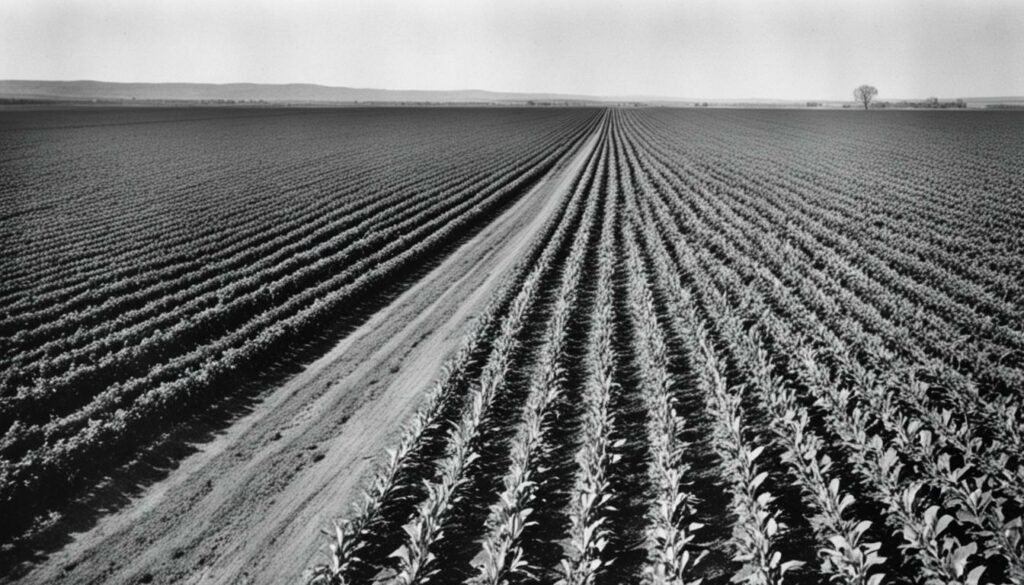
In 1936, parts of the Act were said to be against the law by the Supreme Court. But, the ideas in it were later used in the Soil Conservation and Domestic Allotment Act of 1938. This new Act looked at protecting the land and helping farmers make money in a more complete way.
In the 1970s, agricultural policy saw big changes. The goal was to make more food available. But, this change brought about overproduction in agriculture. This led to long-lasting problems.
The Green Revolution tried to get more crops using new tech and methods. Yet, it caused an economic imbalance in farming. This issue affected many areas.
During the 1970s, policies changed from controlling supplies to encouraging more produce. Earlier policies aimed to keep the farming economy steady. The new path led to too much produce at times. This caused prices to drop and problems for American farmers.
The policy changes in the 1970s hit small farmers hard. Government help to farmers was reduced to save money. As a result, small farmers struggled to keep up with big ones.
They were asked to produce more, leading to practices like monoculture farming. While this boosted output, it also harmed the environment. It made it hard for small farmers to survive against the big industrial farms. This led to less variety in crops and financial trouble for small farmers.
This time showed a big change in how the government helped farmers. What was meant to boost growth made long-term problems in farming. Balancing short-term gains with lasting success and fairness is now a big issue for those in charge.
The shape of farming today has been heavily shaped by two main laws. These are the Food Security Act of 1985 and the 2002 Farm Security and Rural Investment Act. These laws changed how government help and money have been used to change farming a lot.
The Food Security Act of 1985 was designed to keep food production steady. It changed how the farming industry was supported by the government. By offering support and payments, it made more farmers work their land. This included a special program that paid farmers to stop growing on lands that needed rest.
In 2005, this program stopped an area as big as Iowa from being farmed. This helped the land heal, stopped soil from washing away, and protected natural areas.
But, this also made too much food. The aim was to make sure prices were fair and help farmers. Sadly, this led to too many farmers growing on lands that couldn’t produce much or were easily damaged.
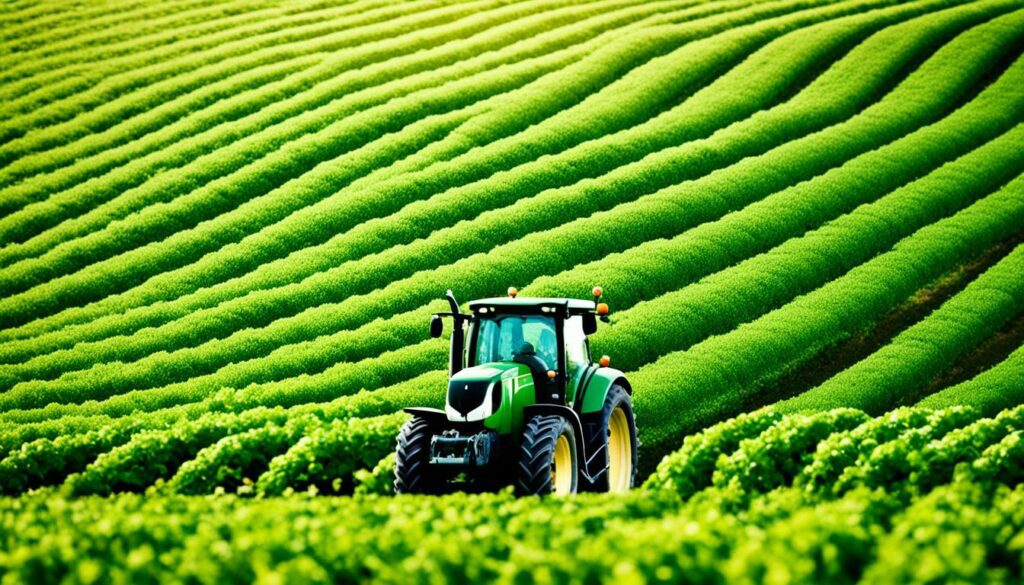
In 2002, the Farm Security Act built on the ideas from 1985. It spent more money to help farmers in different ways. This included giving more farmers insurance for their crops and help when things went wrong. A lot more land was covered by insurance, up to 60% of farmable land in the 48 states.
But, this also meant even more food was produced that the markets didn’t need. During the COVID-19 pandemic, too many fruits and vegetables were grown as shops and restaurants closed. This made groups like The Farmlink Project focus on stopping this wasted food. Many are now pushing for new rules to fix the problem, help small and minority farmers, and move to a more sustainable way of farming.
All these changes show that farming is slowly yet surely getting better. The hope is in President Biden’s plans to make farming more balanced and earth-friendly. These ideas could bring about real improvement.
The overproduction legacy stems from earlier farming policies. It has greatly affected the economy and nature. Policies shaped in the 1970s pushed for more crops and livestock. This overabundance flooded markets and stressed nature heavily.
These actions forced us to rethink our farming strategies. The excessive farming in the 1980s caused farm incomes to fall. This showed the danger of not controlling how much we produce. The focus on more and more, backed by big subsidies and trade barriers, made things worse.
In contrast, Norway’s approach stands out. They focus on small family farms which own around 25 hectares. They also rent a lot of land. By managing farming through quotas and special rules, Norway encourages sustainable agriculture. This helps balance farming and protecting nature.
| Country | Average Farm Size (hectares) | Rented Agricultural Land (%) | Policy Focus |
|---|---|---|---|
| United States | 444 | 39% | Maximising Production |
| Norway | 25 | 50% | Sustainable Agriculture |
Sustainable farming is crucial in tackling the problems of overproduction. Years of study in Norway highlight this. Such policies aim to cut the harm to nature while keeping farms stable.
Our policies need a big change. The overproduction legacy warns us. We must find a way to farm that boosts both making things and caring for the planet. This way, our farming can thrive and be good for the earth.
Today, we’re changing how we farm to make sure it’s good for the planet and fair for everyone. Part of this change is helping out small and minority farms, ensuring they get the aid they need. We’re also pushing for ways to farm that are good for the environment. By doing this, we are aiming for a stronger and more stable farming sector.
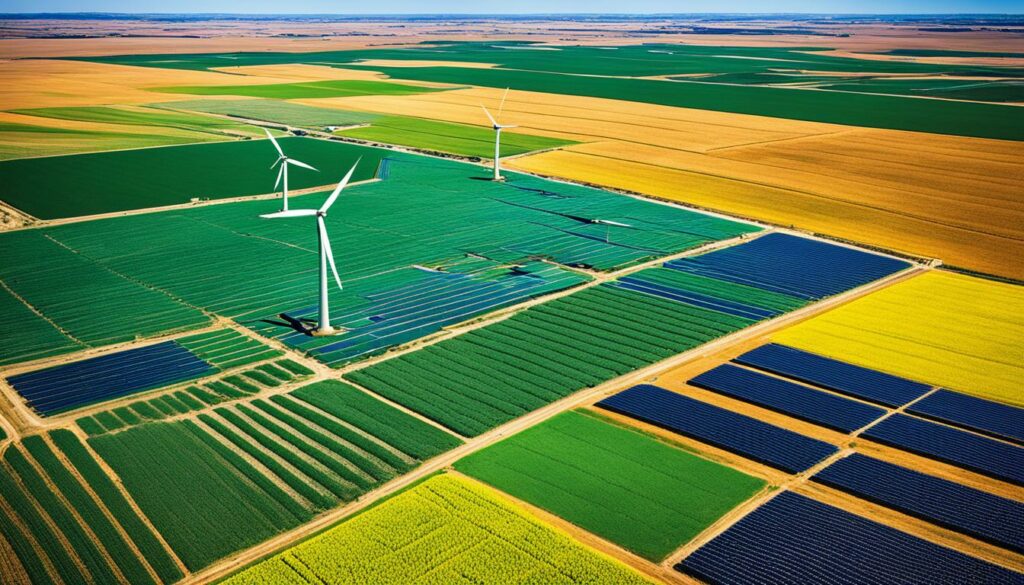
Each year, over $800 billion is put into farming across the world. Studies show that by using some of this money for green ideas and better rural areas, we could see big improvements. These changes could cut down on pollution, make land use better, and help farmers and people who eat the food.
The EU is a good example of making these changes work. They are moving away from giving subsidies for just producing more. Their new approach supports using fewer chemicals, farming organically, and cutting down on greenhouse gases. But, the US has had a hard time with some of its policies, which actually increased pollution.
It’s crucial to support smaller and minority farms to make agriculture more fair. In India, recent changes have faced a lot of criticism. Many small farmers and local governments are not happy with how these changes are taking place. This shows it’s important to plan these support schemes very carefully.
Around the world, we’ve seen some farmers not happy about certain changes. For example, there was a big fuss about banning some fertilisers in Sri Lanka and reducing nitrogen use in the Netherlands. This reminds us that we must think about both helping the planet and keeping these farmers in business.
| Policy Change | Country | Outcome |
|---|---|---|
| Decoupling Subsidies | EU | Reduced GHG emissions |
| Biofuel Policies | US | Higher GHG emissions |
| Inorganic Fertiliser Ban | Sri Lanka | Political resistance |
| Market Reforms | India | Protests from smallholder farmers |
To sum up, we are working hard to make farming more sustainable and fair. Helping small and minority farms is crucial for a strong and equal farming future.
The future of agricultural policy is widely discussed by many, including policymakers, farmers, and those focused on sustainability. The CAP will spend €387 billion between 2021-27, with €291.1 billion from the EAGF and €95.5 billion from the EAFRD. This funding shows Europe’s strong dedication to building a tough agricultural sector. It will help reach goals that focus on being green and using tech in farming.
The government wants agriculture to be more eco-friendly and help smaller farms. They also aim to fight climate change with special support. Now, 25% of direct payments must go to eco-schemes in the 2023-27 CAP. Plus, 40% of the budget must help the climate.
The future seems to move towards digital farming, helped by a €8 billion fund from Next Generation EU. An important part will help young farmers, giving 3% of the direct payment budget. An expected €10 billion from Horizon Europe will boost agriculture research.
Showcasing important allocations and their goals:
| Funding Source | Amount (€ Billion) | Purpose |
|---|---|---|
| CAP Total (2021-27) | 387 | Overall agricultural development |
| EAGF | 291.1 | Agricultural guarantees |
| EAFRD | 95.5 | Rural development |
| Next Generation EU | 8 | Digital transition in rural areas |
| Eco-schemes Allocation | 25% of direct payments | Climate-friendly farming |
| Youth Farmer Support | 3% of direct payments | Young farmer support |
| Horizon Europe | 10 | Research and innovation |
We must understand how new agricultural policies, presidential goals, and upcoming changes merge. This fusion should spur growth in sustainability, competitiveness, and resilience in farming.
Looking at agricultural policies, we see they have deep impacts on farming. There’s a drop in crop yields globally, leading to food insecurity. This causes a need for support for those who must leave their homes, like IDPs and refugees. It’s crucial to make policies that work for the different sizes of land, ranging from Kazakhstan’s huge 30,000 ‘000 ha to Slovenia’s small 231 ‘000 ha.
Each country farms in its unique way, showing agriculture is not the same everywhere. For example, Turkey grows wheat on 8,650,000 ha, which is very different from Ukraine’s 5,910,000 ha. Countries like Moldova and Hungary focus on grapes, with plantations of 401,588 ha and 1,997 ha respectively. But, Ukraine has vast sunflower fields, using 1,513,000 ha, unlike Turkey’s 205,000 ha. These differences need special policies to aid each nation’s farming sector.
Looking at industrial and pasture lands also shows the agriculture sector’s rich variety. Belarus devotes 768,000 ha to grow industrial crops, contrasting with Kazakhstan’s massive 182,326 ‘000 ha for grazing. This differs greatly from the smaller plots in Georgia and Bosnia and Herzegovina. Understanding these distinctions is key for creating policies that help each country’s farming future.
In conclusion, addressing changes in agricultural policies needs a careful, detailed approach. All involved must watch for and understand these changes. This way, we can ensure farming grows sustainably, preparing the agricultural sector for a strong future. For a deep dive into understanding agricultural policies, check out this comprehensive resource.
Agricultural policies have changed a lot since the Great Depression. They began helping farmers financially through the first Farm Bill. Since then, these policies have kept up with how farming changes, even during the COVID-19 pandemic.
The Agricultural Improvement Act of 2018 is a big piece of legislation. It is also called the 2018 Farm Bill and guides policies from 2018 to 2023. This Act covers farming, food, community life, and financial support for farmers.
The COVID-19 pandemic led to some quick changes in policies to help farming. The USDA provided billion to help agribusinesses. This showed how governments can adapt fast to support farming during crises.
The USDA’s Conservation Loan Programme supports green farming. It gives loans but farmers have to follow eco-friendly plans. This aims to blend short-term financial gain with long-term environmental benefits.
Changes in policies can really shake up agribusinesses. They might encourage growing certain crops or offer new loans. This pushes agribusinesses to change how they produce or do business to meet new market and rule demands.
Loans and subsidies are key parts of policies that help farmers. They keep up with what consumers want and spur growth in farming.
New policies bring a lot of challenges to agribusinesses. They have to adapt to new rules fast, see how they affect them, and stay legal. Doing this right is vital for their success and to compete well.
Bankers who know about farming finances are a great help in understanding new policies. They give smart advice on how to grow, follow rules, and plan money when laws change.
Policy changes offer chances for farmers to reach new markets or get help. But they also mean dealing with new rules, huge costs on meeting them, and making hard changes in how they farm.
The Agricultural Adjustment Act aimed to steady crop prices by controlling how much was grown. By lessening production and helping farmers with money, it made crops worth more. But, it also made food cost more and showed how policy, supply, and prices link up.
In the 1970s, policies started wanting farmers to produce more. This aimed to make food easier to get but caused problems like hurting the environment. It made things hard for small farms and led to too much of the same kind of farms.
These acts pushed farming to focus more on particular crops in certain ways. This helped raise crop amounts and pull some people out of being really poor. But, it also made farming focus too much on a few things, creating unevenness in farming.
The legacy of too much farming includes hurting the environment, too much food, and a lot of food waste. This shows a need for smart changes in how we grow food to handle the extra and lessen the harm to the earth.
Modern reforms want farming to be fair and green. They help small farms and support methods that are good for the earth. This aims to even out farming and cut down its harm on the planet.
New leaders might push for more help for small farms and not such large, tough farming. These changes want farming to be fair and keep its future. They could shape the aim of farming towards doing less harm and being fair to all.